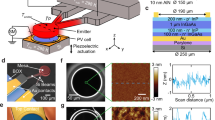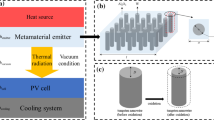Abstract
A mathematical physical model of a near-field thermophotovoltaic (TPV) system containing a metamaterial emitter comprised of W-nanowire arrays embedded in a SiC host is constructed. It is notable that this model incorporates a cooling system. On this basis, the influence of the emitter temperature and filling ratio, the cell and emitter thicknesses, and the emitter cell vacuum gap on the TPV system output performance is analyzed. It is found that the cooling device energy consumption increases by two orders of magnitude with decreased emitter cell gap size in the near-field; the highest possible value is 267.74 W·cm−2. However, the maximum net system efficiency is only 11.79 %. The emitter radiation capability can be enhanced by increasing the emitter temperature, but the cooling system energy consumption remains a significant problem. When the emitter temperature increases to 2200 K, the net system efficiency and net output density reach maximum values of only 6.22 % and 36.28 W·cm−2, respectively. Further investigation demonstrates that a large emitter thickness can induce a surface disturbance phenomenon, resulting in rapid decreases in the net system output power density and net system efficiency to − 251.85 W·cm−2 and − 12.86 %, respectively. However, when the cell thickness increases beyond 1000 nm, the net system efficiency and output power density are stable at 2.13 % and 24.12 W·cm−2, respectively. Finally, the emitter filling ratio should be increased as much as possible to maintain good system performance.






Similar content being viewed by others
References
S. Molesky, C.J. Dewalt, Z. Jacob, High temperature epsilon-near-zero and epsilon-near-pole metamaterial emitters for thermophotovoltaics. Opt. Express 21, A1035–A1051 (2013)
H. Deng, T. Wang, J. Gao, X. Yang, Metamaterial thermal emitters based on nanowire cavities for high-efficiency thermophotovoltaics. J. Opt. 16, 35102 (2014)
J.-Y. Chang, Y. Yang, L. Wang, Tungsten nanowire based hyperbolic metamaterial emitters for near-field thermophotovoltaic applications. Int. J. Heat Mass Transf. 87, 237–247 (2015)
K. Qiu, A.C.S. Hayden, Thermophotovoltaic power generation systems using natural gas-fired radiant burners. Sol. Energy Mater. Sol. Cells 91, 588–596 (2007)
K. Qiu, A.C.S. Hayden, Development of a novel cascading TPV and TE power generation system. Appl. Energy 91, 304–308 (2012)
T.A. Butcher, J.S. Hammonds, E. Horne, B. Kamath, J. Carpenter, D.R. Woods, Heat transfer and thermophotovoltaic power generation in oil-fired heating systems. Appl. Energy 88, 1543–1548 (2011)
E. Shoaei, Performance assessment of thermophotovoltaic application in steel industry. Sol. Energy Mater. Sol. Cells 157, 55–64 (2016)
X. Wu, H. Ye, J. Wang, Experimental analysis of cell output performance for a TPV system. Sol. Energy Mater. Sol. Cells 95, 2459–2465 (2011)
W. Durisch, B. Bitnar, J.-C. Mayor, F. von Roth, H. Sigg, H.R. Tschudi et al., Small self-powered grid-connected thermophotovoltaic prototype system. Appl. Energy 74, 149–157 (2003)
X. Xu, H. Ye, Y. Xu, M. Shen, X. Zhang, X. Wu, Experimental and theoretical analysis of cell module output performance for a thermophotovoltaic system. Appl. Energy 113, 924–931 (2014)
M. Francoeur, R. Vaillon, M.P. Mengüç, Thermal impacts on the performance of nanoscale-gap thermophotovoltaic power generators. IEEE Trans. Energy Convers. 26, 686–698 (2011)
S. Basu, Z.M. Zhang, C.J. Fu, Review of near-field thermal radiation and its application to energy conversion. Int. J. Energy Res. 33, 1203–1232 (2009)
M. Francoeur, M.P. Mengüç, R. Vaillon, Spectral tuning of near-field radiative heat flux between two thin silicon carbide films. J. Phys. Appl. Phys. 43, 75501 (2010)
K. Park, S. Basu, W.P. King, Z.M. Zhang, Performance analysis of near-field thermophotovoltaic devices considering absorption distribution. J. Quant. Spectrosc. Radiat. Transf. 109, 305–316 (2008)
A.W. Bett, S. Keser, O.V. Sulima, Study of Zn diffusion into GaSb from the vapour and liquid phase. J. Cryst. Growth 181, 9–16 (1997)
P.S. Dutta, B. Méndez, J. Piqueras, E. Dieguez, H.L. Bhat, Nature of compensating luminescence centers in Te-diffused and -doped GaSb. J. Appl. Phys. 80, 1112–1115 (1996)
J.A. González-Cuevas, T.F. Refaat, M.N. Abedin, H.E. Elsayed-Ali, Modeling of the temperature-dependent spectral response of In1−χGaχSb infrared photodetectors. Opt. Eng. 45, 44001–0440018 (2006)
J. Yang, K.T. Chan, X. Wu, F.W. Yu, X. Yang, An analysis on the energy efficiency of air-cooled chillers with water mist system. Energy Build. 55, 273–284 (2012)
B. Song, A. Fiorino, E. Meyhofer, P. Reddy, Near-field radiative thermal transport: from theory to experiment. AIP Adv. 5, 053503 (2015)
J.K. Tong, W.-C. Hsu, Y. Huang, S.V. Boriskina, G. Chen, Thin-film “thermal well” emitters and absorbers for high-efficiency thermophotovoltaics. Sci. Rep. 5, 10661 (2015)
M.P. Bernardi, O. Dupré, E. Blandre, P.-O. Chapuis, R. Vaillon, M. Francoeur, Impacts of propagating, frustrated and surface modes on radiative, electrical and thermal losses in nanoscale-gap thermophotovoltaic power generators. Sci. Rep. 5, 11626 (2015)
H. Daneshvar, R. Prinja, N.P. Kherani, Thermophotovoltaics: fundamentals, challenges and prospects. Appl. Energy 159, 560–575 (2015)
X.L. Liu, R.Z. Zhang, Z.M. Zhang, Near-field thermal radiation between hyperbolic metamaterials: graphite and carbon nanotubes. Appl. Phys. Lett. 103, 213102 (2013)
S. Basu, Y. Yang, L. Wang, Near-field radiative heat transfer between metamaterials coated with silicon carbide thin films. Appl. Phys. Lett. 106, 033106 (2015)
X.J. Wang, S. Basu, Z.M. Zhang, Parametric optimization of dielectric functions for maximizing nanoscale radiative transfer. J. Phys. Appl. Phys. 42, 245403 (2009)
O. Ilic, M. Jablan, J.D. Joannopoulos, I. Celanovic, M. Soljačić, Overcoming the black body limit in plasmonic and graphene near-field thermophotovoltaic systems. Opt. Express 20, A366 (2012)
S.-A. Biehs, P. Ben-Abdallah, F.S.S. Rosa, K. Joulain, J.-J. Greffet, Nanoscale heat flux between nanoporous materials. Opt. Express 19, A1088 (2011)
S.-A. Biehs, Thermal heat radiation, near-field energy density and near-field radiative heat transfer of coated materials. Eur. Phys. J. B 58, 423–431 (2007)
Y. Yang, S. Basu, L. Wang, Vacuum thermal switch made of phase transition materials considering thin film and substrate effects. J. Quant. Spectrosc. Radiat. Transf. 158, 69–77 (2015)
Y. Yang, L. Wang, Electrically-controlled near-field radiative thermal modulator made of graphene-coated silicon carbide plates. J. Quant. Spectrosc. Radiat. Transf. 197, 68–75 (2017)
S. Basu, L. Wang, Near-field radiative heat transfer between doped silicon nanowire arrays. Appl. Phys. Lett. 102, 053101 (2013)
S.-A. Biehs, M. Tschikin, P. Ben-Abdallah, Hyperbolic metamaterials as an analog of a blackbody in the near field. Phys. Rev. Lett. 109, 104301 (2012)
H. Wang, X. Liu, L. Wang, Z. Zhang, Anisotropic optical properties of silicon nanowire arrays based on the effective medium approximation. Int. J. Therm. Sci. 65, 62–69 (2013)
S. Basu, M. Francoeur, Penetration depth in near-field radiative heat transfer between metamaterials. Appl. Phys. Lett. 99, 143107 (2011)
Y. Yang, L. Wang, Spectrally enhancing near-field radiative transfer between metallic gratings by exciting magnetic polaritons in nanometric vacuum gaps. Phys. Rev. Lett. 117, 044301 (2016)
E.D. Palik, Handbook of Optical Constants of Solids (Academic Press, Cambridge, 1998)
O.V. Sulima, A.W. Bett, Fabrication and simulation of GaSb thermophotovoltaic cells. Sol. Energy Mater. Sol. Cells 66, 533–540 (2001)
D. Martín, C. Algora, Temperature-dependent GaSb material parameters for reliable thermophotovoltaic cell modelling. Semicond. Sci. Technol. 19, 1040 (2004)
H. Ye, L. Tang, Y. Ma, Experimental and theoretical investigation of zinc diffusion in N-GaSb. Chin. Sci. Bull. 55, 2489–2496 (2010)
P.S. Dutta, B. Méndez, J. Piqueras, E. Dieguez, H.L. Bhat, Nature of compensating luminescence centers in Te-diffused and -doped GaSb. J. Appl. Phys. 80, 1112–1115 (1996)
Funding
This work was supported by the National Natural Science Foundation of China (Grant No. 51406126).
Author information
Authors and Affiliations
Corresponding authors
Additional information
Publisher's Note
Springer Nature remains neutral with regard to jurisdictional claims in published maps and institutional affiliations.
Appendix
Appendix
Calculation method of energy transmission coefficient \( \xi (\omega ,\beta ) \) was reported in papers [3, 13, 23,24,25,26,27,28,29,30]. In particular, papers [3, 13, 24, 28,29,30] have described the calculation method of energy transmission coefficient of multilayer planar structure. A calculation method of energy transmission coefficient between two suspended metamaterial films was reported in papers [23, 27, 31], at the same time. Because in this work, we have studied a five-layer parallel-plate near-field thermophotovoltaic system, combining all the literature above with each other; the expression of energy transmission coefficient \( \xi (\omega ,\beta ) \) between metamaterial emitter and thermophotovoltaic cell for both propagating waves (\( \kappa < \omega /c \)) and evanescent waves (\( \kappa > \omega /c \)) can be expressed as:
Where reflection coefficients R and transmission coefficients T are given by:
Where the subscript number l = 1, 2, 3, 4 or 5 is the layer index shown in Fig. 1a in the main text; ν = s or p represents the polarization states; γ is the vertical-component wavevector, \( \beta \) is the parallel-component wavevector. According to paper [29], if the layer 5 is not a vacuum, the energy associated with propagating waves will be absorbed when it cannot transmit into the vacuum substrate. In this case, \( \left( {1 - \left| {R_{l}^{\nu } } \right|^{2} - \left| {T_{l}^{\nu } } \right|^{2} } \right) \) will be replaced by \( \left( {1 - \left| {R_{l}^{\nu } } \right|^{2} } \right) \) in Eq. 13; \( r_{l - 1 ,l}^{\text{s}} \) and \( r_{l - 1 ,l}^{\text{p}} \) are the Fresnel reflection coefficients for s and p polarizations at the interface of layers l − 1 and l, which can be written as \( r_{l - 1,l}^{s} = (\gamma_{l - 1} - \gamma_{l} )/(\gamma_{l - 1} + \gamma_{l} ) \) and \( r_{l - 1,l}^{p} = (\varepsilon_{l\parallel } \gamma_{l - 1} - \varepsilon_{l - 1,\parallel } \gamma_{l} )/(\varepsilon_{l\parallel } \gamma_{l - 1} + \varepsilon_{l - 1,\parallel } \gamma_{l} ) \) [3, 27, 31], respectively; the metamaterial emitter in this work is an inhomogeneous medium made of tungsten and SiC. When it comes to the calculation of the reflection coefficient of layer 2, \( R_{2}^{\nu } \), the wavelength-dependent dielectric function for the metamaterial emitter is needed, so that according to papers [2, 3, 32, 33], effective medium theory (EMT) is employed here to obtain effective dielectric functions of the emitter by approximating it as a homogeneous medium. In this work, Maxwell–Garnett method (MGM) is applied, which can be expressed as:
and
With the literature research, we know that the permittivity of material can be well described by Drude model and Lorentz model [2, 24, 25, 34, 35], so that in this work, we employed the Drude model to describe the wavelength-dependent dielectric function of tungsten \( \varepsilon_{\text{d}} (\omega ) \) as:
The parameters needed for calculation are obtained from Ref. [36].
However, because SiC is polar material, wavelength-dependent dielectric function \( \varepsilon_{\text{m}} (\omega ) \) is more suitable to describe in Lorentz model [25]:
The parameters needed for calculation are obtained from Ref. [25].
In this work, we have also employed an accurate model for the calculation of dark current in this work as follows.
Refer to Ref. [14], the dark current can be calculated by:
When the temperature of cell is 300 K, the intrinsic carrier concentration \( n_{\text{in}}^{{}} \) is 1.4 × 1012 cm−3 [37]; \( \tau_{\text{e}} \), \( \tau_{\text{h}} \) are the relaxation time of electron and hole, respectively; diffusion coefficient \( D_{\text{h}} \) and \( D_{\text{e}} \) can be calculated by Einstein’s relation: \( D_{n} = \left( {\frac{kT}{q}} \right)\mu_{n} \) [17], where \( \mu_{n} \) is carrier mobility [38] and mobility of electron and hole can be, respectively, calculated by:
The parameters needed for calculation are obtained from Ref. [15, 39, 40].
Rights and permissions
About this article
Cite this article
Xu, Q., Chen, P., Wu, X. et al. Performance Analysis of a Metamaterial-Based Near-Field Thermophotovoltaic System Considering Cooling System Energy Consumption. Int J Thermophys 40, 30 (2019). https://doi.org/10.1007/s10765-019-2496-2
Received:
Accepted:
Published:
DOI: https://doi.org/10.1007/s10765-019-2496-2




